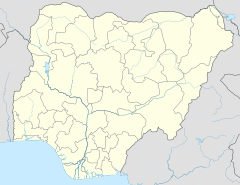Lake Chad Game Reserve
| Lake Chad Game Reserve | ||
|---|---|---|
|
|
||
| Location: | Nigeria | |
| Specialty: | Borno state | |
| Next city: | Maiduguri , Bosso | |
| Surface: | 6073.54 km² | |
The Lake Chad Game Reserve is a nature reserve in the northeast of the Nigerian state of Borno .
location
It covers an area of 6,073.54 km² in the administrative area of the greater municipalities of Bosso , Kurnawa , Baga , Marte and Gambourou at an average height of 280 meters above sea level. On April 30, 2008, it was included in the Ramsar Convention 's list of wetlands of international importance under the title Lake Chad Wetlands in Nigeria . It is classified by the IUCN in Category IV, Biotope / Species Protection Area with Management. It is considered a significant wetland in the Sahel region. The boundaries of the game reserve are determined by the state borders with Niger in the north, Chad in the east, Cameroon in the southeast and the former shoreline of Lake Chad in the west and southwest.
Emergence
The Lake Chad Wetlands in Nigeria and the Game Reserve extend on the former lake bed of the Nigerian part of Lake Chad , the free water surface of which covered this area until the 1970s. With his retreat in the 1970s / 80s, the lake bed became dry and a complex of permanent and seasonal lakes, swamps and wetlands was created. The main water inflows into this wetland are generated by the Komadugu Yobe , Ngadda and Yedseram rivers . Their runoff regime and the amount of precipitation determine the biodiversity of flora and fauna in this area. The water inflow begins in August with the start of the monsoon season and peaks between December and February when the flood season arrives in the river systems. The highest water level in the wetlands is reached in February, during which time they extend to the shorelines of today's Lake Chad.
climate
The climate in the region is known as tropical humid , with a pronounced separation of rainy and dry periods. with minimum temperatures in January of 8 ° C and maximum temperatures in April of 47 ° C. The rainy season extends from May to October and is determined by the rainfall regime of the West African monsoons . The average annual rainfall is around 300 to 400 mm and the evaporation potential ranges from 2300 to over 3000 mm.
Flora and fauna
flora
The soils in these wetlands are called Vertisole loam soils according to the USDA soil classification , regionally they are called firki . The vegetation in this area is called fadama in Hausa , this word refers to seasonal flood plains. This Fadama vegetation is determined by grass and small bush savannahs. Typha domingensis , taller than a man, grows on the watercourses and Mimosa pigra forms in a dense vegetation cover on the borders of the wetlands. Higher tree species occur only sporadically in the wetlands, such as the fragrant acacia ( Acacia nilotica ) and the doum palm species Hyphaene thebaica . Denser gallery forests are forming along the rivers and river deltas .
fauna
The Lake Chad Wetlands are of particular importance for avifauna , especially water birds, and for migratory birds from the northern hemisphere , which use the wetlands as resting and wintering quarters. More than 300 species of birds have been observed in the wetlands, eight of which were new visitors to Nigeria. Threatened bird species in the Lake Chad Wetlands include the double snipe ( Gallinago media ) and the steppe harrier ( Circus macrourus ).
Individual evidence
- ↑ The Annotated Ramsar List: Nigeria ( Memento of October 12, 2013 in the Internet Archive ) (English)
- ↑ OGUNKOYA & Dami: Information Sheet on Ramsar Wetlands (RIS) - 2006-2008 Version ( Memento of the original from October 29, 2013 in the Internet Archive ) Info: The archive link was inserted automatically and has not yet been checked. Please check the original and archive link according to the instructions and then remove this notice. on Wetlands.org (PDF document; 167 kB) (English)
